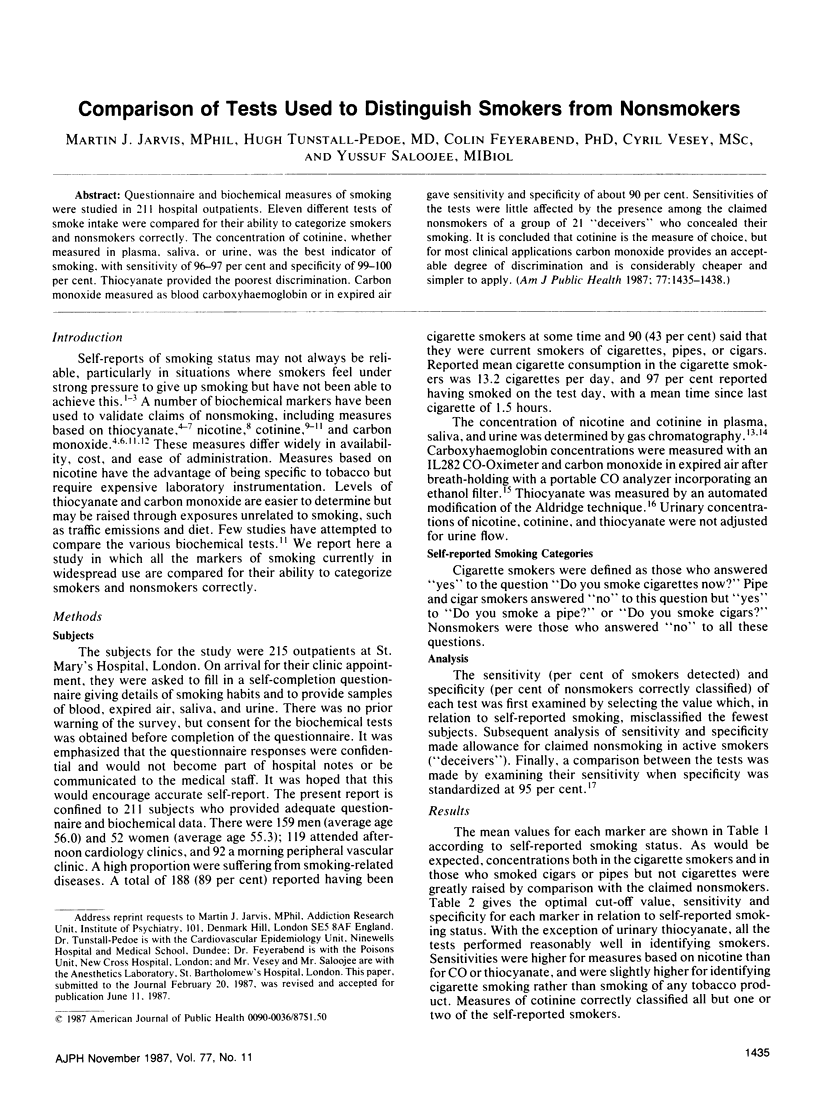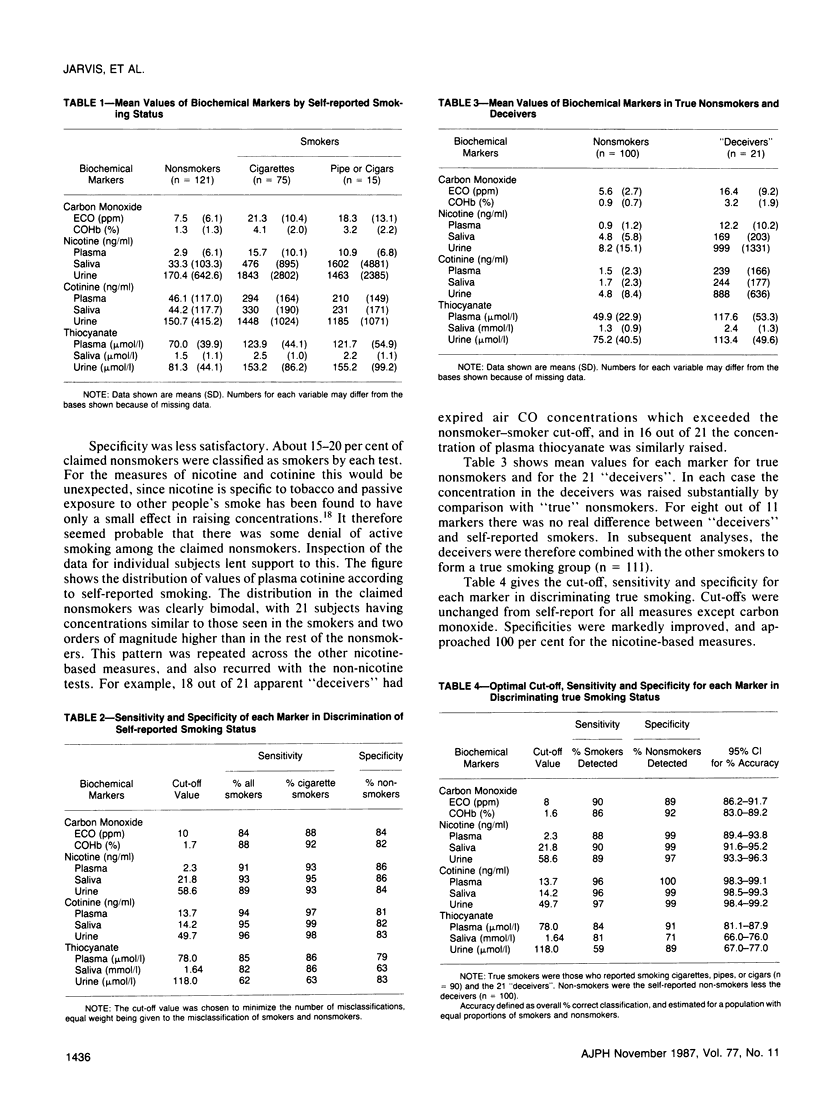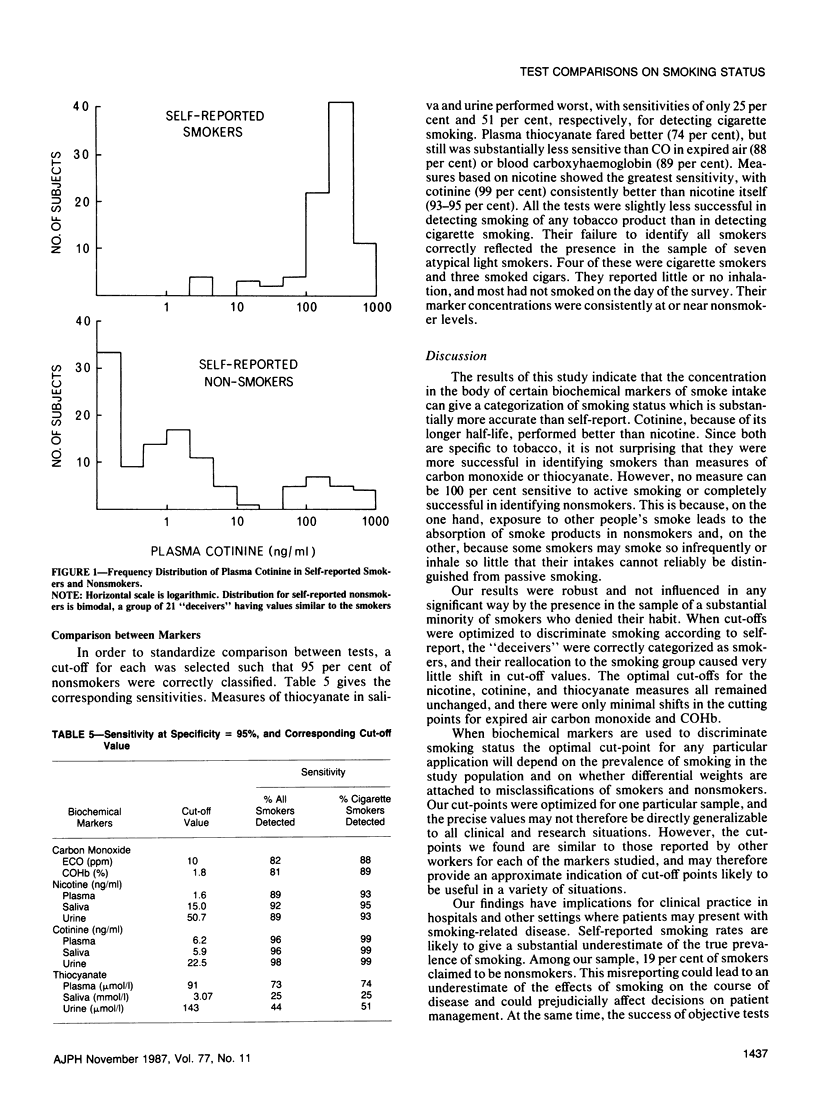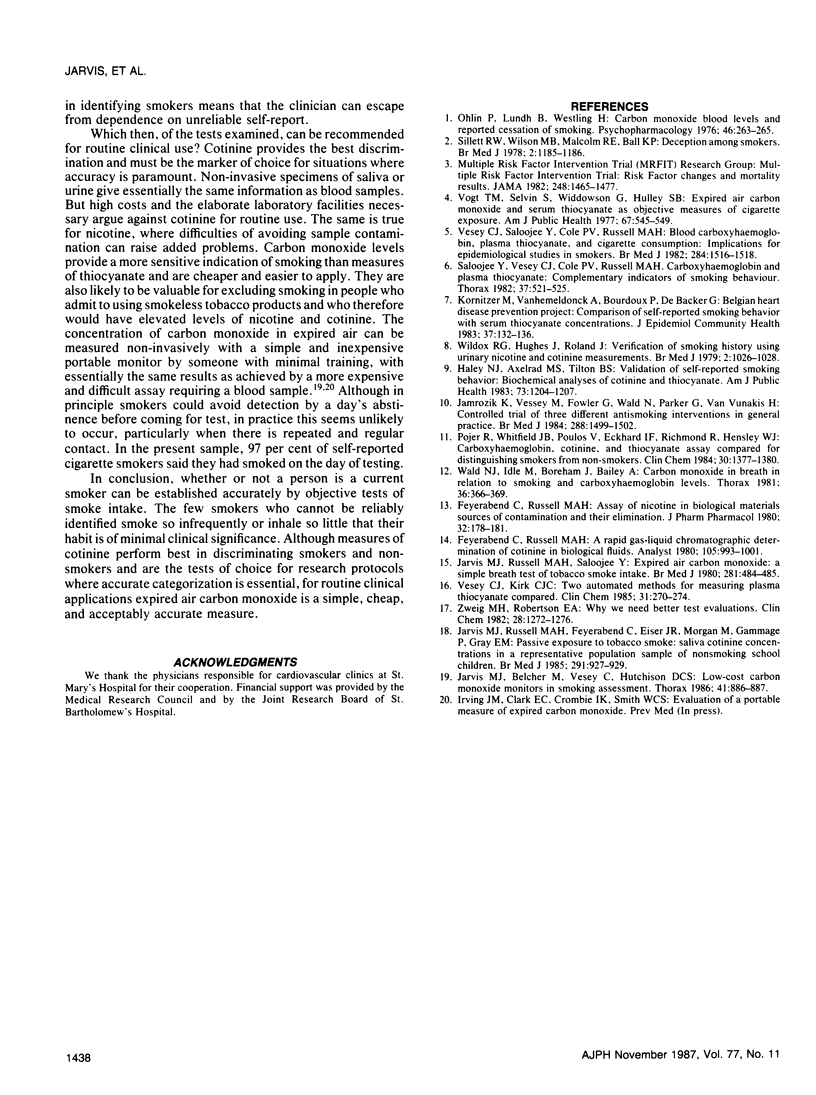Abstract
Questionnaire and biochemical measures of smoking were studied in 211 hospital outpatients. Eleven different tests of smoke intake were compared for their ability to categorize smokers and nonsmokers correctly. The concentration of cotinine, whether measured in plasma, saliva, or urine, was the best indicator of smoking, with sensitivity of 96-97 per cent and specificity of 99-100 per cent. Thiocyanate provided the poorest discrimination. Carbon monoxide measured as blood carboxyhaemoglobin or in expired air gave sensitivity and specificity of about 90 per cent. Sensitivities of the tests were little affected by the presence among the claimed nonsmokers of a group of 21 "deceivers" who concealed their smoking. It is concluded that cotinine is the measure of choice, but for most clinical applications carbon monoxide provides an acceptable degree of discrimination and is considerably cheaper and simpler to apply.
Full text
PDF



Selected References
These references are in PubMed. This may not be the complete list of references from this article.
- Feyerabend C., Russell M. A. Assay of nicotine in biological materials: sources of contamination and their elimination. J Pharm Pharmacol. 1980 Mar;32(3):178–181. doi: 10.1111/j.2042-7158.1980.tb12885.x. [DOI] [PubMed] [Google Scholar]
- Feyerabend C., Russell M. A. Rapid gas-liquid chromatographic determination of cotinine in biological fluids. Analyst. 1980 Oct;105(1255):998–1001. doi: 10.1039/an9800500998. [DOI] [PubMed] [Google Scholar]
- Haley N. J., Axelrad C. M., Tilton K. A. Validation of self-reported smoking behavior: biochemical analyses of cotinine and thiocyanate. Am J Public Health. 1983 Oct;73(10):1204–1207. doi: 10.2105/ajph.73.10.1204. [DOI] [PMC free article] [PubMed] [Google Scholar]
- Jamrozik K., Vessey M., Fowler G., Wald N., Parker G., Van Vunakis H. Controlled trial of three different antismoking interventions in general practice. Br Med J (Clin Res Ed) 1984 May 19;288(6429):1499–1503. doi: 10.1136/bmj.288.6429.1499. [DOI] [PMC free article] [PubMed] [Google Scholar]
- Jarvis M. J., Belcher M., Vesey C., Hutchison D. C. Low cost carbon monoxide monitors in smoking assessment. Thorax. 1986 Nov;41(11):886–887. doi: 10.1136/thx.41.11.886. [DOI] [PMC free article] [PubMed] [Google Scholar]
- Jarvis M. J., Russell M. A., Feyerabend C., Eiser J. R., Morgan M., Gammage P., Gray E. M. Passive exposure to tobacco smoke: saliva cotinine concentrations in a representative population sample of non-smoking schoolchildren. Br Med J (Clin Res Ed) 1985 Oct 5;291(6500):927–929. doi: 10.1136/bmj.291.6500.927. [DOI] [PMC free article] [PubMed] [Google Scholar]
- Jarvis M. J., Russell M. A., Saloojee Y. Expired air carbon monoxide: a simple breath test of tobacco smoke intake. Br Med J. 1980 Aug 16;281(6238):484–485. doi: 10.1136/bmj.281.6238.484. [DOI] [PMC free article] [PubMed] [Google Scholar]
- Kornitzer M., Vanhemeldonck A., Bourdoux P., de Backer G. Belgian heart disease prevention project: comparison of self-reported smoking behaviour with serum thiocyanate concentrations. J Epidemiol Community Health. 1983 Jun;37(2):132–136. doi: 10.1136/jech.37.2.132. [DOI] [PMC free article] [PubMed] [Google Scholar]
- Ohlin P., Lundh B., Westling H. Carbon monoxide blood levels and reported cessation of smoking. Psychopharmacology (Berl) 1976 Sep 29;49(3):263–265. doi: 10.1007/BF00426827. [DOI] [PubMed] [Google Scholar]
- Pojer R., Whitfield J. B., Poulos V., Eckhard I. F., Richmond R., Hensley W. J. Carboxyhemoglobin, cotinine, and thiocyanate assay compared for distinguishing smokers from non-smokers. Clin Chem. 1984 Aug;30(8):1377–1380. [PubMed] [Google Scholar]
- Saloojee Y., Vesey C. J., Cole P. V., Russell M. A. Carboxyhaemoglobin and plasma thiocyanate: complementary indicators of smoking behaviour? Thorax. 1982 Jul;37(7):521–525. doi: 10.1136/thx.37.7.521. [DOI] [PMC free article] [PubMed] [Google Scholar]
- Sillett R. W., Wilson M. B., Malcolm R. E., Ball K. P. Deception among smokers. Br Med J. 1978 Oct 28;2(6146):1185–1186. doi: 10.1136/bmj.2.6146.1185. [DOI] [PMC free article] [PubMed] [Google Scholar]
- Vesey C. J., Kirk C. J. Two automated methods for measuring plasma thiocyanate compared. Clin Chem. 1985 Feb;31(2):270–274. [PubMed] [Google Scholar]
- Vesey C. J., Saloojee Y., Cole P. V., Russell M. A. Blood carboxyhaemoglobin, plasma thiocyanate, and cigarette consumption: implications for epidemiological studies in smokers. Br Med J (Clin Res Ed) 1982 May 22;284(6328):1516–1518. doi: 10.1136/bmj.284.6328.1516. [DOI] [PMC free article] [PubMed] [Google Scholar]
- Vogt T. M., Selvin S., Widdowson G., Hulley S. B. Expired air carbon monoxide and serum thiocyanate as objective measures of cigarette exposure. Am J Public Health. 1977 Jun;67(6):545–549. doi: 10.2105/ajph.67.6.545. [DOI] [PMC free article] [PubMed] [Google Scholar]
- Wald N. J., Idle M., Boreham J., Bailey A. Carbon monoxide in breath in relation to smoking and carboxyhaemoglobin levels. Thorax. 1981 May;36(5):366–369. doi: 10.1136/thx.36.5.366. [DOI] [PMC free article] [PubMed] [Google Scholar]
- Wilcox R. G., Hughes J., Roland J. Verification of smoking history in patients after infarction using urinary nicotine and cotinine measurements. Br Med J. 1979 Oct 27;2(6197):1026–1028. doi: 10.1136/bmj.2.6197.1026. [DOI] [PMC free article] [PubMed] [Google Scholar]
- Zweig M. H., Robertson E. A. Why we need better test evaluations. Clin Chem. 1982 Jun;28(6):1272–1276. [PubMed] [Google Scholar]


